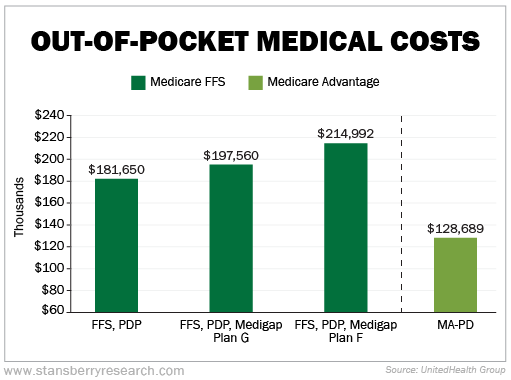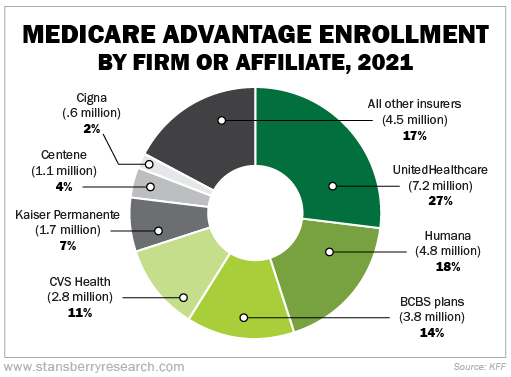Our health care system is so dysfunctional...
The incentives are wrong. Doctors and hospitals are rewarded for over-testing and overtreating, instead of being paid to prevent illness.
The good news is some people have created a better system. Their program realigns the incentives patients see at the hospital or doctor's office. It's designed specifically for seniors. And this new arrangement is so powerful that it can save you around $100,000 over the course of retirement and improve your health.
Better yet, I (Thomas Carroll) have been watching this happen from the start... and I can show you how to take advantage of it...
I've spent my entire career in health care finance. After I finished graduate school at the Johns Hopkins Bloomberg School of Public Health, my first job was with a start-up health care company.
I'm passionate about this industry. We are all customers. Health is our most important asset, and it needs to be managed like any other important asset we own, such as our house and our savings.
This is especially important as we plan for and navigate our retirement years.
Health care costs so much money in the U.S. that many people can't wait to get Medicare. They believe that once they're enrolled, they can finally stop worrying about potential financial ruin from a costly health care event.
But most people don't realize that Medicare won't cover all their costs. There are limits, and many things are not covered, like long-term care, most dental care, or routine eye exams. This can add up to tens of thousands of dollars. It's an expense that often goes unplanned for and can overwhelm your hard-earned retirement savings.
Regular Medicare comes in two parts – Part A and Part B. This is often referred to as Medicare fee for service ("FFS").
Part A is "hospital" insurance. It covers a lot of the cost of an inpatient stay in a hospital. The Medicare taxes paid during your career entitle you to Part A benefits.
Part B is "doctor" insurance. This part of Medicare pays for the doctor services you receive. However, your Part B benefits will cost you $144 to $492 a month depending on your income.
These two parts will cover between 60% and 70% of your expected medical costs. But they don't cover prescription drugs.
You can also bundle these insurance products together and add two other common things: a Medigap policy that covers the "gaps" in Medicare benefits, and a prescription drug plan ("PDP"). These three things together can cost hundreds of dollars a month in premiums you have to pay.
On average, a healthy 65-year-old can expect to live another 21 years. In that time, they will be responsible for around $200,000 of medical expenses. This must be paid for with savings.
Below is a chart illustrating what a 65-year-old can expect to pay out of pocket within his or her remaining lifetime.
With the three common Medicare FFS options shown, a retiree must spend between $181,000 and $215,000 in premiums, deductibles, and co-payments over the course of their 21 years.
But the Medicare Advantage ("MA") program offers a different way...
You can enroll in a Medicare Advantage plan with a private insurance company. The company will collect a premium from you, the funds from the government, and combine all the parts of Medicare to manage your coverage.
Rather than having to coordinate all your Medicare "parts," juggle numerous cards, and figure out which pays for what... under Medicare Advantage, you get a single insurance card, like how you probably did when you were working.
You have different choices for how extensive or expensive you'd like a plan you to be. In 2021, the Medicare Advantage program offered an average of 33 options to Medicare beneficiaries at lower out-of-pocket costs to people who received benefits this way.
These plans offer everything from $0 premium plans to higher cost plans that have little to no payment when you go to the doctor. They're typically combined with prescription drug benefits, vision, dental, and even fitness programs. You should check out SilverSneakers... It's a fitness-and-social program that's offered free of charge through many MA plans.
Why is this important to understand? Two reasons... First, if you've never heard of MA, now is your chance to explore these easy-to-use, benefit-rich plans. And second, it could save you tens of thousands of dollars.
You can get the same coverage that was estimated to cost above $200,000 with a Medicare Advantage plan for about $129,000.
This difference is huge for most retirees living on a fixed income or just their savings.
The other benefit is qualitative. An MA plan is very user-friendly. "Young" Medicare-eligible people often find MA easier to use. It's similar to using the employer-sponsored health benefits they've become accustomed to during their careers. Who wouldn't want to switch from a modern health plan to one that was created in the 1960s?
MA plans bundle everything together in one simple, affordable option. You carry one health care card in your pocket, instead of three (Medicare card, Medigap card, and PDP card).
The plans also offer additional benefits to help keep you healthy, rather than just treat problems. The company you sign up with is rewarded for keeping your lifetime health care costs low. They do that not by rejecting claims, but by helping you stay healthy.
The companies that run these plans send out advertisements to attract new enrollees. They are looking for you. But too many seniors think that it's just a sales pitch and don't dig in.
I am an unbiased analyst. Our only incentive at our publisher, Stansberry Research, is to deliver you valuable truths so that you stick with us as subscribers. After more than a decade of analyzing these plans, I believe they are a win-win scenario for most patients. You get more affordable coverage and better health outcomes.
But what I really like about it is that it's a uniquely American idea that has been successful. It's government funded, but privately administered.
This isn't the government managing your health care. These are sophisticated, technology-enabled, efficient organizations that extract considerable value for their "members" – the people who sign up.
If you need further convincing, just look to your fellow Medicare beneficiaries.
Currently, 26 million people with Medicare get their benefits this way. That's 42% of the total Medicare population and the highest it has ever been. And it's continuing to grow as the baby-boom generation continues to "age in" to Medicare.
Who offers these kinds of health plans?
In 2021, UnitedHealthcare and Humana were the two largest insurance companies offering coverage. United has 27% of the market, while Humana has another 18%. Together, these two companies make up almost half of the MA market nationwide. Each has been involved for the last two decades. They've been through the ups and downs of the program, so they know it well.
The other half is covered by Blue Cross Blue Shield companies, CVS Health, and a multitude of other health insurance companies.
So do yourself, your parents, or grandparents a favor and look into the MA plans that are available to you where you live.
As of Friday, October 15, you can enroll in one of these health plans. If you've never heard of Medicare Advantage, I urge you to see what options are available where you live. You can do that at Medicare.gov.
Please consider a Medicare Advantage plan. Now is the time to do it.
In last night's issue of Retirement Millionaire, I recommended investing in a health insurer that has spent two decades perfecting its business model – just in time for a fresh wave of customers...
If you're not already a subscriber, click here to get started – and learn the name of our latest investment advice.
Best regards,
Thomas Carroll
November 11, 2021


